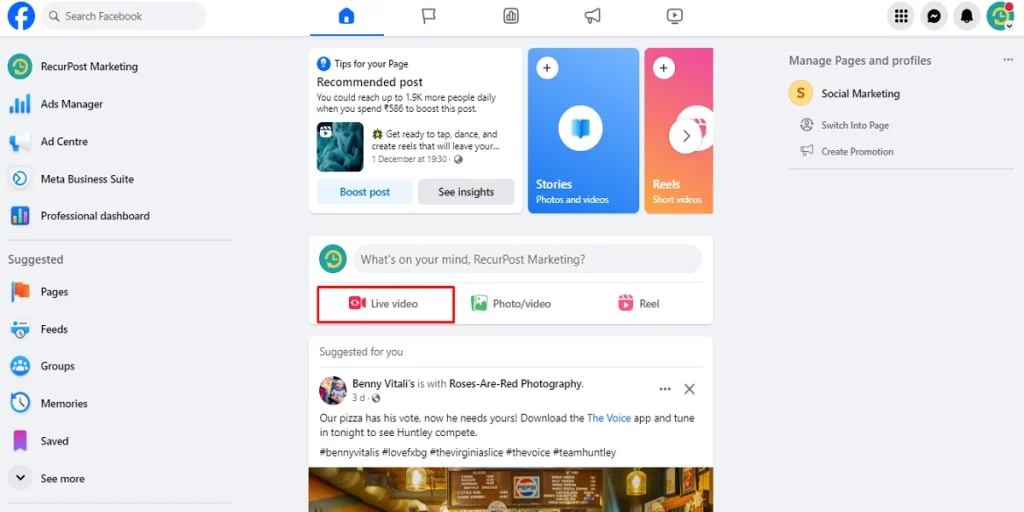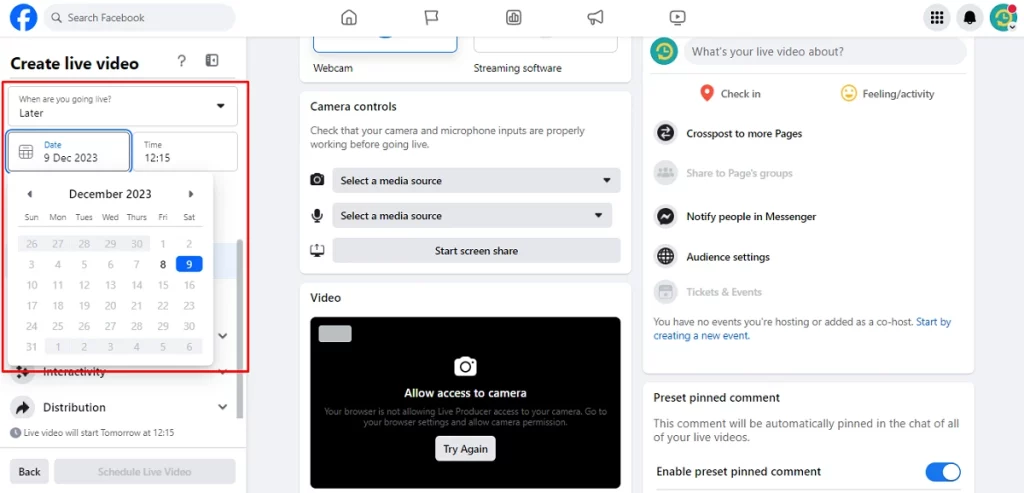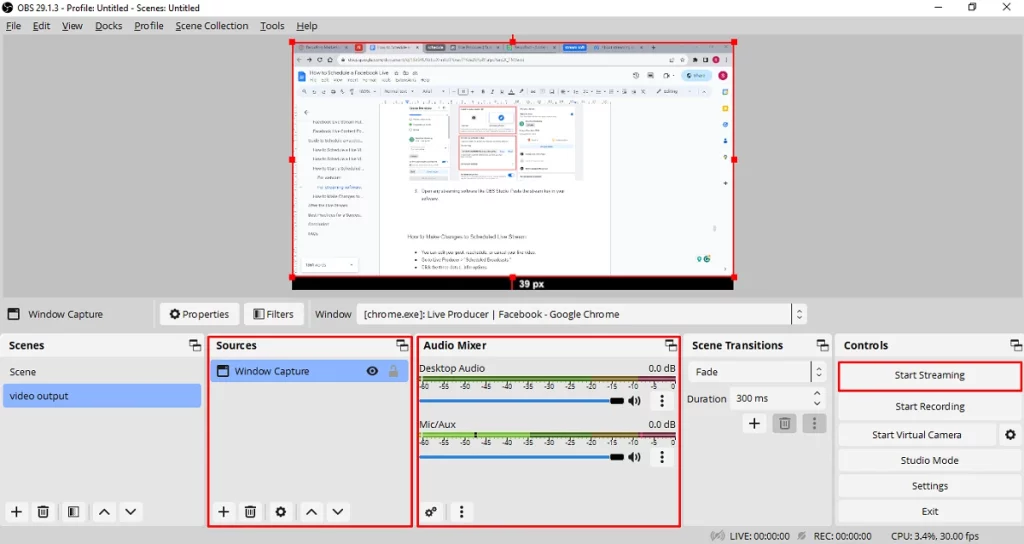Going Live on Facebook to engage with your audience and promote your business can seem intimidating. That’s why learning how to schedule a Facebook Live properly is key to driving audience growth.
Facebook’s integrated scheduling feature is not only useful for planning live video events ahead of time but also effective in drawing viewers, especially when you have a limited number of followers. For instance, you can schedule Facebook posts related to your upcoming live video across different pages and groups.
Whether planning spontaneous live streams or more polished events, booking them ahead of time ensures higher visibility.
In this guide, I’ll show you, step-by-step, how to schedule and make the most of your live video events. Let’s get started!
Preparing for Your Facebook Live
Properly setting up both the technical and content aspects of your live stream ahead of time helps ensure a smooth broadcast. Consider this pre-planning checklist:
Technical Setup:
- Equipment- Ensure decent lighting, audio pickup, camera stability, and appealing backdrops using tripods, microphones, ring lights, etc. The quality doesn’t have to be perfect, but optimizing will build more trust with viewers.
- Internet Connection- A stable and fast internet connection is essential for smooth streaming. Aim for an upload speed of at least 5 Mbps. Recommended 4G network for Mobile users.
- Software – Facebook’s official tool – Meta Business Suite for managing your live streams. For more advanced features like overlays and graphics, consider using streaming software like OBS Studio or VMix.
Content Planning:
- Choosing a Topic- Select subjects that resonate with your audience’s interests and align with your brand. Also, consider preparing content that complements your live streams, like learning how to schedule reels on Facebook. These can act as teasers or follow-ups, keeping your audience engaged.
- Scripting- Outline talking points to sound polished and natural on camera without rambling. Time and practice run-throughs.
- Rehearsals- Practice to ensure a polished and professional presentation by creating a test broadcast before going live.
Facebook Live Stream Rules
When scheduling live streams, keep these Facebook rules in mind:
- Your stream will automatically go live at the set time. You must be connected within 10 minutes or the broadcast will automatically end.
- For a normal Facebook Go Live stream you can only schedule up to 24 hours in advance. But for an official Facebook Live Event, you can promote and schedule up to 1 year out.
- The minimum scheduling lead time is 10 minutes in advance. Anything less will be rejected.
- You cannot stream a single live broadcast across multiple destinations like Pages or Groups simultaneously anymore. This crossposting is restricted now. However, you can crosspost to more than one page.
Facebook Live Content Policies
Additionally, Facebook enforces rules around deceptive and copyright-infringing live streams:
- Cannot broadcast pre-recorded videos deceptively implying they are live.
- Cannot falsely claim a location the stream isn’t coming from.
- Any pre-recorded portions must have clear labels indicating they are not live.
- Music usage faces restrictions – keep songs short and get rights-holders approvals.
Guide to Schedule a Facebook Live
Ready to schedule a Facebook Live and engage your audience? Follow these simple steps:
Go Live or Live Video Event?
First, decide between Go Live (schedule up to 24 hours in advance) and Live Video Event (schedule up to 1 year in advance).
How to Schedule a Facebook Live Video (Go Live):
1. Click on the “Live Video” under the ”What’s on your mind section”.

2. Choose your posting destination.

3. Click “Select” on the Go Live card.

4. Click “Later” in the left menu and select the desired date and time.

5. Write the Title and Description to schedule a post.

6. Click “Schedule live video”.

How to Schedule a Facebook Live Video Event:
1. Head to Facebook Live Producer.
2. Choose the posting destination. (Steps 1 & 2 are the same as Scheduling a Live Video)
3. Click “Select” on the “Create live video event” card.

4. Add event details: name, description, date, and time.

5. Click “Next” and “Create Event”.

How to Start a Scheduled Live Stream:
For webcam:
1. Go to Live Producer.
2. Scroll down to “Scheduled Broadcasts”.

3. Find your video and click “Set up live video”.

4. Click “Go Live Now” when ready.

For streaming software:
1. Go to Facebook Live Producer.
2. Select the Video Source as Streaming Software and copy the Stream Key.

3. Open any streaming software like OBS Studio. Paste the stream key in your software.

4. Add the Video source by choosing the Video capture device and make sure the correct Audio input is selected. When you have finished the setup, click Start Streaming.

How to Make Changes to Scheduled Live Stream:
- You can edit your post, reschedule, or cancel your live video.
- Go to Live Producer > “Scheduled Broadcasts.”
- Click the three dots (…) for options.

Is your scheduled Facebook live stream not working properly? Check out all the detailed issues and their solutions here.
After the Live Stream
After your Facebook Live stream, it’s important to keep the momentum going.
1. Reposting Live Stream Content:
Reposting the content effectively extends its lifecycle. Consider creating highlight reels showcasing the best moments from your stream. These can be shared across social media platforms, reaching audiences who might have missed the live event.
Reposting the entire session as a video on your Facebook page offers a second chance for viewership. Remember to share this content in relevant Facebook groups to tap into new audiences.

2. Analyzing Performance:
Facebook offers robust analytics including
- Reach and Impressions – The total number of users who saw your live broadcast or any replay content, regardless of whether they clicked or interacted with it. This metric gives you insights into how often your content was shown.
- Interactions – Any likes, comments, shares, or other engagements with your live stream or related posts. This signifies how compelling your content is to viewers.
- Peak Live Viewers – The maximum number of simultaneous people watching during the broadcast. Indicates drawing power.
- Average Watch Time – The average duration viewed per person. Are people sticking around or dropping off quickly?
These metrics offer valuable information about your audience’s preferences and behaviors. Understanding the demographics of your viewers can help tailor your content for future streams, ensuring it resonates more effectively with your target audience.

Best Practices for a Successful Live Stream
To ensure a successful Facebook Live stream, consider these best practices:
- Technical Tips: Conduct a test broadcast. This helps iron out any technical issues and ensures a smooth live session.
- Audience Engagement: Interact with viewers by responding to comments and questions. This personal touch can significantly boost viewer engagement and loyalty.
- Promotion Strategies: Use multiple channels like Facebook Ads, social media posts, and emails to promote your live stream. Engage with relevant groups by scheduling Facebook group posts, or consider running contests to drum up excitement.
- Monetization:
1. Facebook Stars: Stars are a virtual good that lets you earn money and interact with your followers. Meta pays for the stars that you receive.
To be eligible for Stars, creators must have 500 followers for at least 30 consecutive days, and live in a country where Stars is available.
2. Subscriptions: Create a subscription for your Page and earn a monthly income. You can offer exclusive benefits and grow the community of people who subscribe to support you.
To be eligible for Subscriptions, creators must have 10,000 followers or 250+ return viewers. Pages also must meet one of the following criteria in the last 60 days: 50,000 engagements on posts. 180,000 minutes of video watched by followers.
3. In-Stream Ads: Include short ads in your Live and previously live videos to earn money.
To qualify for in-stream ads you need: At least 10,000 followers. 600,000 total minutes viewed in the last 60 days.
These strategies enhance the quality of your live stream and maximize your reach and potential revenue.
Conclusion
In conclusion, scheduling and conducting a successful Facebook Live stream is a straightforward process that can significantly enhance your digital presence.
By following the steps for preparation, scheduling, and post-event strategies, you can engage more effectively with your audience. Utilizing tools like Facebook Stars and in-stream ads also offers monetization opportunities.
I recommend you explore Facebook Live in your social media plan. It’s an excellent approach to building your brand by connecting with the audience and boosting engagement.
FAQs
Scheduling a Facebook Live often leads to better engagement as it allows you to promote the event in advance, build anticipation, and prepare high-quality content.
You can schedule a Facebook Live up to one year in advance, but ideally, it should be a few days to a week before the event to maximize promotion and audience readiness.
Essential equipment includes a reliable camera or smartphone, good lighting, a stable internet connection, and a clear audio setup. A tripod can also enhance stability.
Use channels like social media posts, Facebook Ads, email marketing, and group postings. Engaging content and reminders can also boost anticipation.
Actively interact with viewers by answering questions, acknowledging comments, and maintaining a lively and approachable demeanor throughout the stream.

Saurabh Chaturvedi is a content writer at RecurPost. Specializing in social media management and marketing, Saurabh is dedicated to crafting engaging and informative articles. His passion for clear, exciting content keeps readers eager for more.
